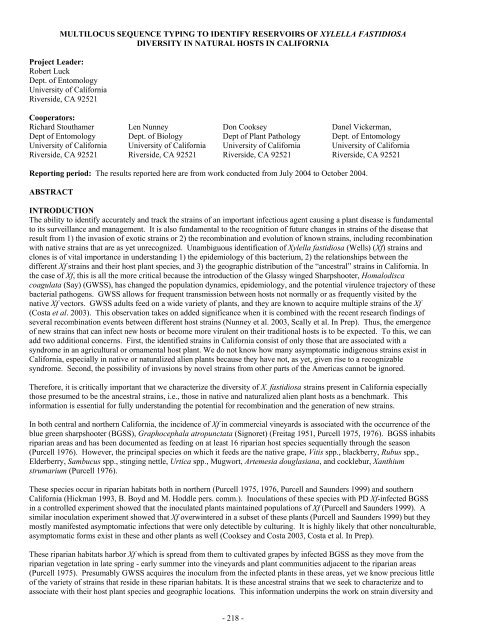Impact Of Host Plant Xylem Fluid On Xylella Fastidiosa Multiplication ...
Impact Of Host Plant Xylem Fluid On Xylella Fastidiosa Multiplication ...
Impact Of Host Plant Xylem Fluid On Xylella Fastidiosa Multiplication ...
Create successful ePaper yourself
Turn your PDF publications into a flip-book with our unique Google optimized e-Paper software.
MULTILOCUS SEQUENCE TYPING TO IDENTIFY RESERVOIRS OF XYLELLA FASTIDIOSA<br />
DIVERSITY IN NATURAL HOSTS IN CALIFORNIA<br />
Project Leader:<br />
Robert Luck<br />
Dept. of Entomology<br />
University of California<br />
Riverside, CA 92521<br />
Cooperators:<br />
Richard Stouthamer<br />
Dept of Entomology<br />
University of California<br />
Riverside, CA 92521<br />
Len Nunney<br />
Dept. of Biology<br />
University of California<br />
Riverside, CA 92521<br />
Don Cooksey<br />
Dept of <strong>Plant</strong> Pathology<br />
University of California<br />
Riverside, CA 92521<br />
Danel Vickerman,<br />
Dept. of Entomology<br />
University of California<br />
Riverside, CA 92521<br />
Reporting period: The results reported here are from work conducted from July 2004 to October 2004.<br />
ABSTRACT<br />
INTRODUCTION<br />
The ability to identify accurately and track the strains of an important infectious agent causing a plant disease is fundamental<br />
to its surveillance and management. It is also fundamental to the recognition of future changes in strains of the disease that<br />
result from 1) the invasion of exotic strains or 2) the recombination and evolution of known strains, including recombination<br />
with native strains that are as yet unrecognized. Unambiguous identification of <strong>Xylella</strong> fastidiosa (Wells) (Xf) strains and<br />
clones is of vital importance in understanding 1) the epidemiology of this bacterium, 2) the relationships between the<br />
different Xf strains and their host plant species, and 3) the geographic distribution of the “ancestral” strains in California. In<br />
the case of Xf, this is all the more critical because the introduction of the Glassy winged Sharpshooter, Homalodisca<br />
coagulata (Say) (GWSS), has changed the population dynamics, epidemiology, and the potential virulence trajectory of these<br />
bacterial pathogens. GWSS allows for frequent transmission between hosts not normally or as frequently visited by the<br />
native Xf vectors. GWSS adults feed on a wide variety of plants, and they are known to acquire multiple strains of the Xf<br />
(Costa et al. 2003). This observation takes on added significance when it is combined with the recent research findings of<br />
several recombination events between different host strains (Nunney et al. 2003, Scally et al. In Prep). Thus, the emergence<br />
of new strains that can infect new hosts or become more virulent on their traditional hosts is to be expected. To this, we can<br />
add two additional concerns. First, the identified strains in California consist of only those that are associated with a<br />
syndrome in an agricultural or ornamental host plant. We do not know how many asymptomatic indigenous strains exist in<br />
California, especially in native or naturalized alien plants because they have not, as yet, given rise to a recognizable<br />
syndrome. Second, the possibility of invasions by novel strains from other parts of the Americas cannot be ignored.<br />
Therefore, it is critically important that we characterize the diversity of X. fastidiosa strains present in California especially<br />
those presumed to be the ancestral strains, i.e., those in native and naturalized alien plant hosts as a benchmark. This<br />
information is essential for fully understanding the potential for recombination and the generation of new strains.<br />
In both central and northern California, the incidence of Xf in commercial vineyards is associated with the occurrence of the<br />
blue green sharpshooter (BGSS), Graphocephala atropunctata (Signoret) (Freitag 1951, Purcell 1975, 1976). BGSS inhabits<br />
riparian areas and has been documented as feeding on at least 16 riparian host species sequentially through the season<br />
(Purcell 1976). However, the principal species on which it feeds are the native grape, Vitis spp., blackberry, Rubus spp.,<br />
Elderberry, Sambucus spp., stinging nettle, Urtica spp., Mugwort, Artemesia douglasiana, and cocklebur, Xanthium<br />
strumarium (Purcell 1976).<br />
These species occur in riparian habitats both in northern (Purcell 1975, 1976, Purcell and Saunders 1999) and southern<br />
California (Hickman 1993, B. Boyd and M. Hoddle pers. comm.). Inoculations of these species with PD Xf-infected BGSS<br />
in a controlled experiment showed that the inoculated plants maintained populations of Xf (Purcell and Saunders 1999). A<br />
similar inoculation experiment showed that Xf overwintered in a subset of these plants (Purcell and Saunders 1999) but they<br />
mostly manifested asymptomatic infections that were only detectible by culturing. It is highly likely that other nonculturable,<br />
asymptomatic forms exist in these and other plants as well (Cooksey and Costa 2003, Costa et al. In Prep).<br />
These riparian habitats harbor Xf which is spread from them to cultivated grapes by infected BGSS as they move from the<br />
riparian vegetation in late spring - early summer into the vineyards and plant communities adjacent to the riparian areas<br />
(Purcell 1975). Presumably GWSS acquires the inoculum from the infected plants in these areas, yet we know precious little<br />
of the variety of strains that reside in these riparian habitats. It is these ancestral strains that we seek to characterize and to<br />
associate with their host plant species and geographic locations. This information underpins the work on strain diversity and<br />
- 218 -











